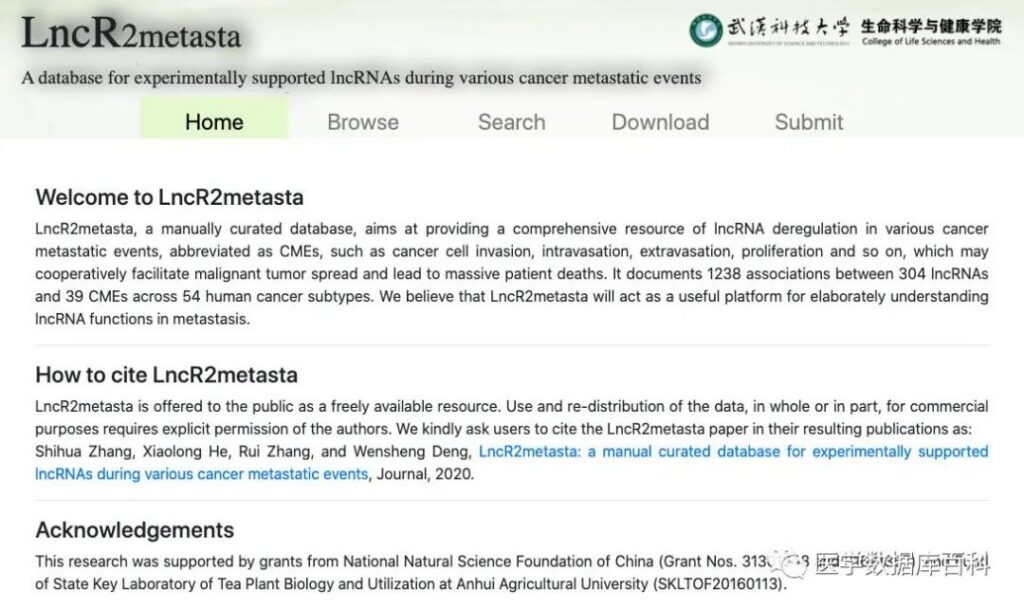LncRNA database related to tumor metastasis
- Normal Liver Cells Found to Promote Cancer Metastasis to the Liver
- Nearly 80% Complete Remission: Breakthrough in ADC Anti-Tumor Treatment
- Vaccination Against Common Diseases May Prevent Dementia!
- New Alzheimer’s Disease (AD) Diagnosis and Staging Criteria
- Breakthrough in Alzheimer’s Disease: New Nasal Spray Halts Cognitive Decline by Targeting Toxic Protein
- Can the Tap Water at the Paris Olympics be Drunk Directly?
LncRNA database related to tumor metastasis
LncRNA database related to tumor metastasis. The experimentally verified database database is actually similar to the review. The review is based on a topic to search for relevant documents, and then use words to summarize the relevant characteristics of these documents.
For this kind of experimentally verified database, the first step is to manually search for relevant documents. The second step is to present relevant information in the literature in the form of a database. The advantage of this is that we can get the information retrieved by the author.
Regarding the experimentally verified database, I have introduced a few before. For details, please check our second and third push. The database I will introduce to you today is an lncRNA database related to tumor metastasis: LncR2metasta(http://lncr2metasta.wchoda.com/)

Database usage
This database provides two methods that can be used:
Browse mode: In this module, we can browse all the information of a certain aspect of the database.
Search mode: If we have the target lncRNA, we can search directly
Below we briefly introduce these two functions.
2.1 Browse mode
In the browse mode, we can search based on the type of lncRNA or tumor metastasis events. For example, suppose we want to look at lncRNAs related to tumor cell invasion.
In this part, we can see the basic description of this classification and the lncRNA obtained in the database.

Among the lncRNAs related to this classification, we can see the gene names of lncRNAs; related research tumors and the ID numbers of lncRNAs in different databases. Furthermore, we can click on the gene name of lncRNA to see the description in the specific literature. In this part, we can see that the information about this gene in the experiment includes: experiment-related information; the function of the gene and a simple description in the literature, etc.

2.2 Search mode
If we have the lncRNA we want to search, we can search in this mode. What we need to do is: i) select the tumor metastasis event; ii) the type of lncRNA; iii) enter the lncRNA that we want to retrieve.
For example, we enter here: H19

Similarly, the results are also presented in tabular form, and we click on the relevant lncRNA. You can also see specific article information.

Database usage scenarios
The above is the basic usage of the database, except for the basic usage scenarios. We also provide a few thoughts and possible experimental scenarios here.
When we are doing bio-credit analysis, we often get a lot of metastasis-related lncRNAs.
If we want to find an lncRNA for downstream experiments, then innovation must be considered. Definitely find the best one that has never been done. At this time, we can use this database to check if anyone has done the lncRNA we obtained.
Suppose we find several lncRNAs related to tumor metastasis during the analysis. Then we must make relevant introductions when we discuss. The general discussion is also based on the previous literature. At this time, we can use this database to search. If there is information, you can use the description in the database.
Sum up
The above is the basic use of the database, and the database provides a download function. We can download all the data in the database. The information included in the downloaded form is quite complete. This is convenient for us to search in batches.

(source:internet, reference only)
Disclaimer of medicaltrend.org



